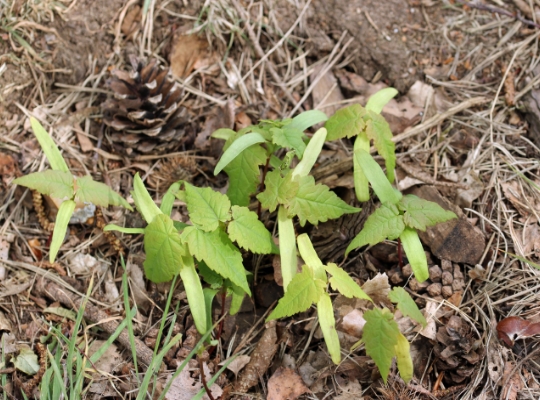Natural regeneration can refer to seedling establishment, either under existing or recent tree cover and in areas where there has not been recent woodland.
The latter is sometimes referred to as ‘natural colonisation’ if it depends on wider dispersal of seed from local seed sources and can help to expand woodlands. Using natural regeneration may encourage adaptation through natural selection and should therefore be considered where appropriate, so that species adapt to current local site conditions and to the changing climate.
Use of natural regeneration may lower the risk of wind damage compared to planted stands, due to the development of more even root systems, and by reducing wind loading if the stand structure is uneven. The presence of an existing naturally regenerated understorey within a stand can also allow faster recovery of the stand following windthrow.
Drought risk is likely to be reduced because of the better rooting in regenerated trees, compared to nursery stock which may suffer root damage during transfer. If the regeneration is within stands, the shade and shelter provided may also protect from drought and frost risk.
Stands with a large amount of understorey vegetation resulting from natural regeneration may have a higher risk of fires spreading to the crowns than uniform-aged stands due to the vertical continuity of fuel.
Natural regeneration can reduce establishment costs depending on the availability of a suitable seed bank. It may be necessary to thin stands to allow seedling recruitment, and there may be increased management requirements including ground preparation and measures to protect seed and seedlings, more weeding and subsequent thinning. There may also be increased harvesting costs due to the complexity of stands and the larger assortment of timber sizes.
There are also practical constraints to achieving successful natural regeneration that need to be managed, including variability of seed production, seed viability, seed predation by rodents and birds, within-stand light availability, weed competition, and browsing of seedlings by deer.

For further advice see the UKFS Practice Guide ‘Adapting forest and woodland management to the changing climate’
Printed copies are available to purchase from Forest Research.
"*" indicates required fields
The following risks may be reduced if the adaptation measure is applied appropriately:
Find out how natural regeneration is being encouraged as part of a research project in Wales to transform the land to continuous cover forestry.
Find out how managers are encouraging natural regeneration in this native Caledonian pinewood, to conserve genetic diversity.